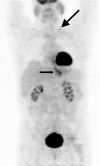Staging esophageal cancer
- PMID: 18852079
- PMCID: PMC2582495
- DOI: 10.1102/1470-7330.2008.9007
Staging esophageal cancer
Abstract
Accurate staging of disease is necessary in patients with newly diagnosed esophageal cancer in order to prompt appropriate curative or palliative therapy. Computed tomography (CT) may be used to evaluate for local spread into adjacent structures (T4 disease) and to diagnose distant metastases (M1). Endoscopic ultrasonography (EUS) is the modality of choice for distinguishing T1 tumors from higher stage lesions and for detecting and sampling regional lymph nodes (N1 disease). Positron emission tomography (PET) scanning is most helpful for detecting previously occult distant metastases. Optimal staging generally requires a multimodality approach.
Figures









Similar articles
-
[Diagnosis of esophageal cancer using positron emission tomography].Nihon Geka Gakkai Zasshi. 2002 Apr;103(4):325-30. Nihon Geka Gakkai Zasshi. 2002. PMID: 11993219 Japanese.
-
Multimodality assessment of esophageal cancer: preoperative staging and monitoring of response to therapy.Radiographics. 2009 Mar-Apr;29(2):403-21. doi: 10.1148/rg.292085106. Radiographics. 2009. PMID: 19325056 Review.
-
Section III: endoscopic and other staging techniques.Semin Thorac Cardiovasc Surg. 2003 Apr;15(2):180-6. Semin Thorac Cardiovasc Surg. 2003. PMID: 12838488 Review.
-
The role and clinical value of EUS in a multimodality esophageal carcinoma staging program with CT and positron emission tomography.Gastrointest Endosc. 2007 Mar;65(3):377-84. doi: 10.1016/j.gie.2006.12.015. Gastrointest Endosc. 2007. PMID: 17321235 Clinical Trial.
-
Is positron emission tomography useful in locoregional staging of esophageal cancer? Results of a multidisciplinary initiative comparing CT, positron emission tomography, and EUS.Gastrointest Endosc. 2008 Mar;67(3):402-9. doi: 10.1016/j.gie.2007.09.006. Gastrointest Endosc. 2008. PMID: 18178202
Cited by
-
Prognostic value of baseline 18F-FDG PET/CT in patients with esophageal squamous cell carcinoma treated with definitive (chemo)radiotherapy.Radiat Oncol. 2023 Feb 24;18(1):41. doi: 10.1186/s13014-023-02224-5. Radiat Oncol. 2023. PMID: 36829219 Free PMC article.
-
A preoperative pathological staging prediction model for esophageal cancer based on CT radiomics.BMC Cancer. 2025 Feb 19;25(1):298. doi: 10.1186/s12885-025-13697-w. BMC Cancer. 2025. PMID: 39972430 Free PMC article.
-
Endoscopic ultrasound-based radiomics for predicting pathologic upgrade in esophageal low-grade intraepithelial neoplasia.Surg Endosc. 2025 Apr;39(4):2239-2249. doi: 10.1007/s00464-025-11573-z. Epub 2025 Feb 10. Surg Endosc. 2025. PMID: 39930119
-
Elective nodal irradiation or involved-field irradiation in definitive chemoradiotherapy for esophageal squamous cell cancer: a retrospective analysis in clinical N0 patients.Curr Oncol. 2018 Oct;25(5):e423-e429. doi: 10.3747/co.25.3895. Epub 2018 Oct 31. Curr Oncol. 2018. PMID: 30464693 Free PMC article.
-
Preliminary Study of MR and Fluorescence Dual-mode Imaging: Combined Macrophage-Targeted and Superparamagnetic Polymeric Micelles.Int J Med Sci. 2018 Jan 1;15(2):129-141. doi: 10.7150/ijms.21610. eCollection 2018. Int J Med Sci. 2018. PMID: 29333097 Free PMC article.
References
-
- Bogot N, Quint L. CT in esophageal cancer. In: Rankin SC, editor. Carcinoma of the esophagus. Cambridge: Cambridge University Press; 2008. pp. p. 62–84.
-
- New York: Springer-Verlag; 2002. AJCC cancer staging handbook.
-
- Patti MG, Gantert W, Way LW. Surgery of the esophagus. Anatomy and physiology. Surg Clin North Am. 1997;77:959–70. - PubMed
-
- Riquet M, Saab M, Le Pimpec Barthes F, Hidden G. Lymphatic drainage of the esophagus in the adult. Surg Radiol Anat. 1993;15:209–11. - PubMed
-
- SEER NCI. 2008. Cancer of the esophagus. http://seer.cancer.gov/statfacts/html/esoph.html.
Publication types
MeSH terms
LinkOut - more resources
Full Text Sources
Medical
